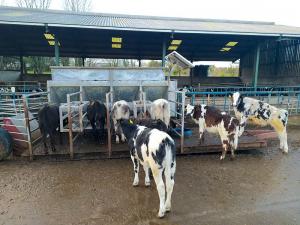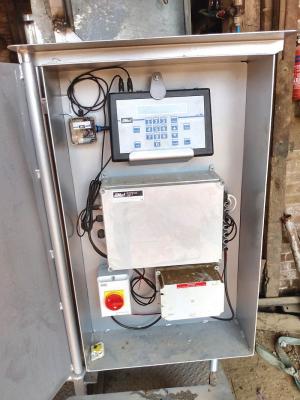Solar-Powered Feeder Eliminates Waste
Matt Ford’s calves get all the feed they need with minimal waste thanks to his solar-powered, moveable cattle feeder. Ear tags identify each calf to sensors on the feeder, which then delivers portions of the calf’s daily feed allotment. Half the allotment is available in the morning and half in the afternoon.
“The calves can stay in place and the feed will continue to be delivered in small amounts, or they can leave and return for the rest of their ration,” says Ford. “Some calves eat their entire ration at once, and others come back multiple times through the day.”
Ford designed the feeding system for dairy heifers to compensate for the poor-quality forage in the drained marshland on his farm. Environmental rules prevent fertilizing or reseeding. While multiple years of intensive grazing helped, supplemental feeding was needed.
“We dropped piles of feed on the ground, but we are near the ocean, and seagulls took a lot, plus we couldn’t regulate how much each animal got,” says Ford. “Some were quick and others too slow, and we ended up with waste and worm problems.”
His solution was a battery-powered, Out of Parlor feeding system from Agricultural Technology Limited (www.atlagri.com). He mounted it on a low trailer so it could be moved between paddocks. Steel dividers create 4 single animal feed stalls on each side. Initially Ford added pallets to the dividers to ensure one-per-stall feeding with smaller calves. Later he fabricated steel replacements to fit over the dividers when needed.
A steel box added to one end houses the battery and onboard processor to run the sensors and feed delivery gates. He installed a small solar panel to top off the battery, but quickly found that a second battery and a larger panel were needed. He also made some modifications to the hopper to strengthen it and make it more watertight.
The 8-stall system can easily handle 200 head a day, delivering the prescribed amount of feed and tracking how much was eaten and when.
“Some animals will visit the feeder 16 to 17 times a day, while others will visit 2 to 3 times,” says Ford.
The entire system came to about $13,700. The trailer cost about $2,745, and the feeding unit was about $9,600. The remainder covered the cost of the solar panels and other components.
Contact: FARM SHOW Followup, Ford Partners, Herstmonceux, East Sussex, United Kingdom BN27 1RG (ph 011 44 777 997 3938; office@fordpartners.co.uk).

Click here to download page story appeared in.
Click here to read entire issue
Solar-Powered Feeder Eliminates Waste LIVESTOCK Feeding Equipment Matt Ford’s calves get all the feed they need with minimal waste thanks to his solar-powered moveable cattle feeder Ear tags identify each calf to sensors on the feeder which then delivers portions of the calf’s daily feed allotment Half the allotment is available in the morning and half in the afternoon “The calves can stay in place and the feed will continue to be delivered in small amounts or they can leave and return for the rest of their ration ” says Ford “Some calves eat their entire ration at once and others come back multiple times through the day ” Ford designed the feeding system for dairy heifers to compensate for the poor-quality forage in the drained marshland on his farm Environmental rules prevent fertilizing or reseeding While multiple years of intensive grazing helped supplemental feeding was needed “We dropped piles of feed on the ground but we are near the ocean and seagulls took a lot plus we couldn’t regulate how much each animal got ” says Ford “Some were quick and others too slow and we ended up with waste and worm problems ” His solution was a battery-powered Out of Parlor feeding system from Agricultural Technology Limited www atlagri com He mounted it on a low trailer so it could be moved between paddocks Steel dividers create 4 single animal feed stalls on each side Initially Ford added pallets to the dividers to ensure one-per-stall feeding with smaller calves Later he fabricated steel replacements to fit over the dividers when needed A steel box added to one end houses the battery and onboard processor to run the sensors and feed delivery gates He installed a small solar panel to top off the battery but quickly found that a second battery and a larger panel were needed He also made some modifications to the hopper to strengthen it and make it more watertight The 8-stall system can easily handle 200 head a day delivering the prescribed amount of feed and tracking how much was eaten and when “Some animals will visit the feeder 16 to 17 times a day while others will visit 2 to 3 times ” says Ford The entire system came to about $13 700 The trailer cost about $2 745 and the feeding unit was about $9 600 The remainder covered the cost of the solar panels and other components Contact: FARM SHOW Followup Ford Partners Herstmonceux East Sussex United Kingdom BN27 1RG ph 011 44 777 997 3938; office@fordpartners co uk
To read the rest of this story, download this issue below or click
here to register with your account number.








